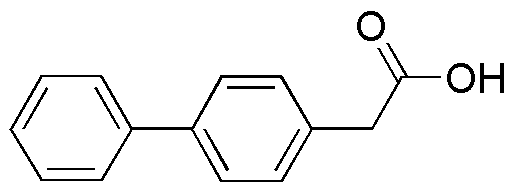4-Biphenylacetic acid is widely utilized in research focused on:
- Pharmaceutical Development: This compound serves as a key intermediate in the synthesis of various pharmaceuticals, particularly those targeting pain relief and anti-inflammatory effects.
- Polymer Chemistry: It is used in the production of specialty polymers, enhancing material properties such as thermal stability and mechanical strength, making it valuable in the plastics industry.
- Organic Synthesis: Researchers employ it in organic synthesis reactions, particularly in the formation of complex organic molecules, which can lead to new drug discoveries.
- Analytical Chemistry: The compound is utilized as a standard in analytical methods, aiding in the quantification of related substances in various samples, ensuring quality control in manufacturing.
- Environmental Applications: It has potential uses in the development of biodegradable materials, contributing to sustainability efforts in reducing plastic waste.
General Information
Properties
Safety and Regulations
Applications
4-Biphenylacetic acid is widely utilized in research focused on:
- Pharmaceutical Development: This compound serves as a key intermediate in the synthesis of various pharmaceuticals, particularly those targeting pain relief and anti-inflammatory effects.
- Polymer Chemistry: It is used in the production of specialty polymers, enhancing material properties such as thermal stability and mechanical strength, making it valuable in the plastics industry.
- Organic Synthesis: Researchers employ it in organic synthesis reactions, particularly in the formation of complex organic molecules, which can lead to new drug discoveries.
- Analytical Chemistry: The compound is utilized as a standard in analytical methods, aiding in the quantification of related substances in various samples, ensuring quality control in manufacturing.
- Environmental Applications: It has potential uses in the development of biodegradable materials, contributing to sustainability efforts in reducing plastic waste.
Documents
Safety Data Sheets (SDS)
The SDS provides comprehensive safety information on handling, storage, and disposal of the product.
Product Specification (PS)
The PS provides a comprehensive breakdown of the product’s properties, including chemical composition, physical state, purity, and storage requirements. It also details acceptable quality ranges and the product's intended applications.
Certificates of Analysis (COA)
Search for Certificates of Analysis (COA) by entering the products Lot Number. Lot and Batch Numbers can be found on a product’s label following the words ‘Lot’ or ‘Batch’.
*Catalog Number
*Lot Number
Certificates Of Origin (COO)
This COO confirms the country where the product was manufactured, and also details the materials and components used in it and whether it is derived from natural, synthetic, or other specific sources. This certificate may be required for customs, trade, and regulatory compliance.
*Catalog Number
*Lot Number
Safety Data Sheets (SDS)
The SDS provides comprehensive safety information on handling, storage, and disposal of the product.
DownloadProduct Specification (PS)
The PS provides a comprehensive breakdown of the product’s properties, including chemical composition, physical state, purity, and storage requirements. It also details acceptable quality ranges and the product's intended applications.
DownloadCertificates of Analysis (COA)
Search for Certificates of Analysis (COA) by entering the products Lot Number. Lot and Batch Numbers can be found on a product’s label following the words ‘Lot’ or ‘Batch’.
*Catalog Number
*Lot Number
Certificates Of Origin (COO)
This COO confirms the country where the product was manufactured, and also details the materials and components used in it and whether it is derived from natural, synthetic, or other specific sources. This certificate may be required for customs, trade, and regulatory compliance.

